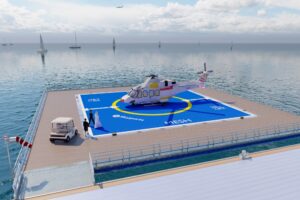Building a high school drone program can be an exciting and rewarding endeavor. Drones offer a dynamic way to engage students in STEM (Science, Technology, Engineering, and Math) education, providing hands-on learning experiences that are both educational and fun.
Here’s a comprehensive guide to help you get started.
7 steps to build a high school drone program
1. Define your program’s goals
Start by identifying the goals of your drone program. Are you focusing on STEM education, preparing students for FAA Part 107 certification, or exploring career pathways in drone technology? Clear goals will help shape your curriculum and resource needs.
Additionally, consider the type of program you want to establish. It could be an after-school program that offers flexible learning opportunities, an elective course integrated into the school day, or a required class providing broad exposure to drone technology for all students.
Determining how many students will be part of the program is also crucial as it will guide your budget and purchasing decisions. As a former educator, I recommend starting small and scaling up. Find a few dedicated students and plan to meet 2-3 times a week after school. Logistics and requirements will depend on your school or district’s rules, but starting small will give you the freedom to work out the kinks.
2. Purchase the right drones for a high school drone program
Selecting the right drones is crucial. For high school programs, you’ll want drones that are durable, easy to use, and provide educational value.
The Crazyflie drone from DroneBlocks tops The Drone Girl’s list of best educational drones for a STEM program. The Crazyflie drone starts at $379, and students can learn to assemble the drone, use it to code, and more. Plus, the purchase of the drone includes a 7-day free trial of the DroneBlocks curriculum, but more on that later.
The Raspberry Pi drone kit from Drone Dojo offers the most comprehensive training tool you could possibly find for learning how to build a drone. The drone kit is $900 and includes the Raspberry Pi 4B, Pixhawk Flight Controller, Drone Frame, RC Transmitter, and Receiver, as well as video tutorials teaching you how to put them together.
Alternatively, if your drone program plans to focus more on learning to fly drones or drone photography/videography, then a beginner drone like the DJI Mini 4K might be a suitable option. You’ll lose out on the ability to teach coding, but for only $299, you’ll get a great drone for teaching the basics of flying.
3. Understand Part 107 requirements
To operate drones legally in an educational setting, you need to comply with FAA regulations. Someone involved in the program, likely the teacher, must hold a Remote Pilot Certificate (Part 107 license).
There are plenty of great online part 107 online test prep courses, but the Drone Pilot Ground School is Drone Girl’s top pick. (Plus use coupon code DRONEGIRL50 to save $50).
If you are an educator on a budget (aka every educator) check out the FAA’s free Part 107 UAS online training course. However, this tool is a supplemental tool and won’t cover everything found on the Part 107 test.
The Part 107 requirements include being at least 16 years old and passing an aeronautical knowledge test at an FAA-approved testing center. This can also be a great curriculum component, offering students the chance to earn their Part 107 certification once they turn 16. Drone Pilot Ground School partners with schools across various programs, offering their program and curriculum to students.
Additionally, Drone Pilot Ground School offers scholarships for high school aspiring commercial drone pilots. They offer around 100 scholarships each semester for those interested in becoming FAA-certified.
4. Develop a curriculum
There are tons of drone-based educational content and lesson plans for high school students. Some are even free and available online.
When choosing the right curriculum for your program, consider factors such as the length of the course, budget, goals, and your student’s prior knowledge.
You may need to search a little further than Teachers Pay Teachers (which has limited drone-related lesson plan options), but reputable sources are out there.
DroneBlocks is one of Drone Girl’s favorite all-inclusive drone education curriculums. STEM educators can purchase the curriculum for $495 per year (hardware not included) and include over 40 courses covering a range of topics such as advanced programming in Python and JavaScript, drag-and-drop block coding, access to a drone simulator, and more.
For educators on a tight budget, Khan Academy is a free online site with lessons, exercises, and quizzes. Their “Crash Course in Indoor Flying Robots” is a great place to start.
5. Engage students and parents
Engaging students, parents, and the community is key to the success of your drone program. Start discussing your plan with everyone you can. Through these connections, you might find a parent eager to volunteer or a community member who works with drones.
Booking guest speakers for your program is another way to build excitement and show your students different possibilities.
Once the program is up and running, communicate regularly with parents about program goals, progress, and achievements. Show them the practical applications and benefits for their children.
6. Secure funding and resources
Funding can be a major hurdle. Explore various funding sources such as school budgets, grants, sponsorships, and fundraising.
DonorsChoose is a great fundraising tool, and there are often anonymous donors looking to support STEAM programs.
There are many STEAM grant opportunities available, but navigating grant writing can be tricky. Depending on your school or district, there may be someone who specializes in grant writing. Try to connect with that person or anyone who has experience.
Also, be sure to take advantage of any teacher or student drone discounts available.
7. Have fun!
One of the best things about starting your program is no pressure of standardized tests. A drone program allows you and your students to learn in a stress-free environment.
So, embrace the opportunity to teach high school students about drones and all the benefits they offer.
The post How to build a high school drone program: a step-by-step guide appeared first on The Drone Girl.
 In the lush fields of the Swiss town of Forel, volunteers use drones to find fawns nestled beneath tall grasses, preventing farmers from inadvertently harming them with heavy agricultural machinery. Hundreds of fawns have been killed or mutilated in Swiss agricultural fields, prompting Fondation Sauvetage Faons (the Fawn Rescue Foundation) in the Vaud canton to […]
In the lush fields of the Swiss town of Forel, volunteers use drones to find fawns nestled beneath tall grasses, preventing farmers from inadvertently harming them with heavy agricultural machinery. Hundreds of fawns have been killed or mutilated in Swiss agricultural fields, prompting Fondation Sauvetage Faons (the Fawn Rescue Foundation) in the Vaud canton to […] In the lush fields of the Swiss town of Forel, volunteers use drones to find fawns nestled beneath tall grasses, preventing farmers from inadvertently harming them with heavy agricultural machinery. Hundreds of fawns have been killed or mutilated in Swiss agricultural fields, prompting Fondation Sauvetage Faons (the Fawn Rescue Foundation) in the Vaud canton to […]
In the lush fields of the Swiss town of Forel, volunteers use drones to find fawns nestled beneath tall grasses, preventing farmers from inadvertently harming them with heavy agricultural machinery. Hundreds of fawns have been killed or mutilated in Swiss agricultural fields, prompting Fondation Sauvetage Faons (the Fawn Rescue Foundation) in the Vaud canton to […]









